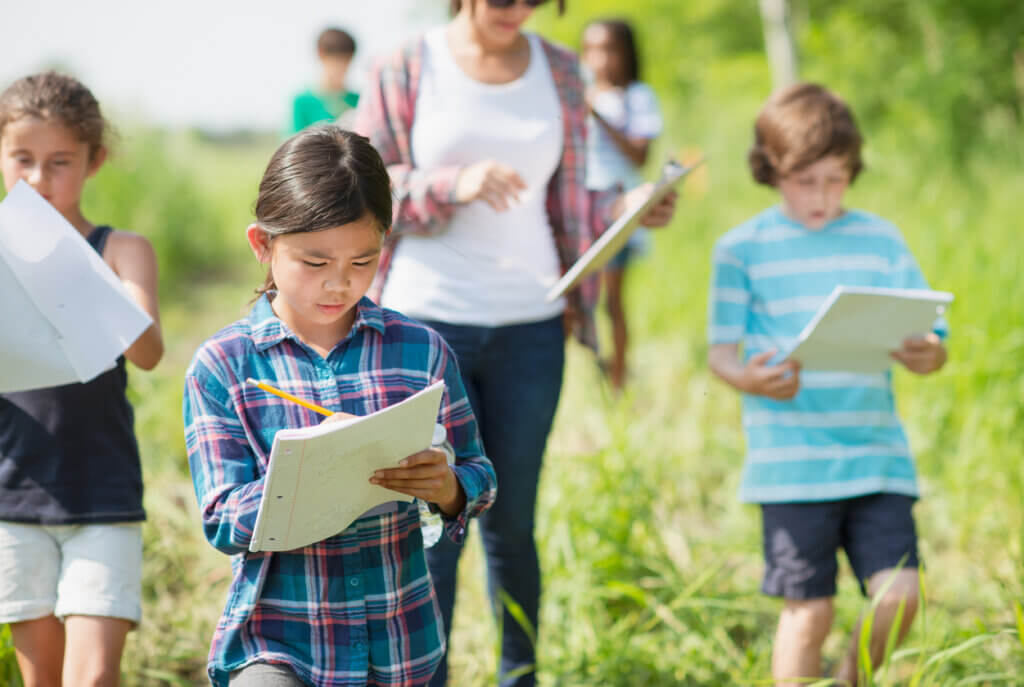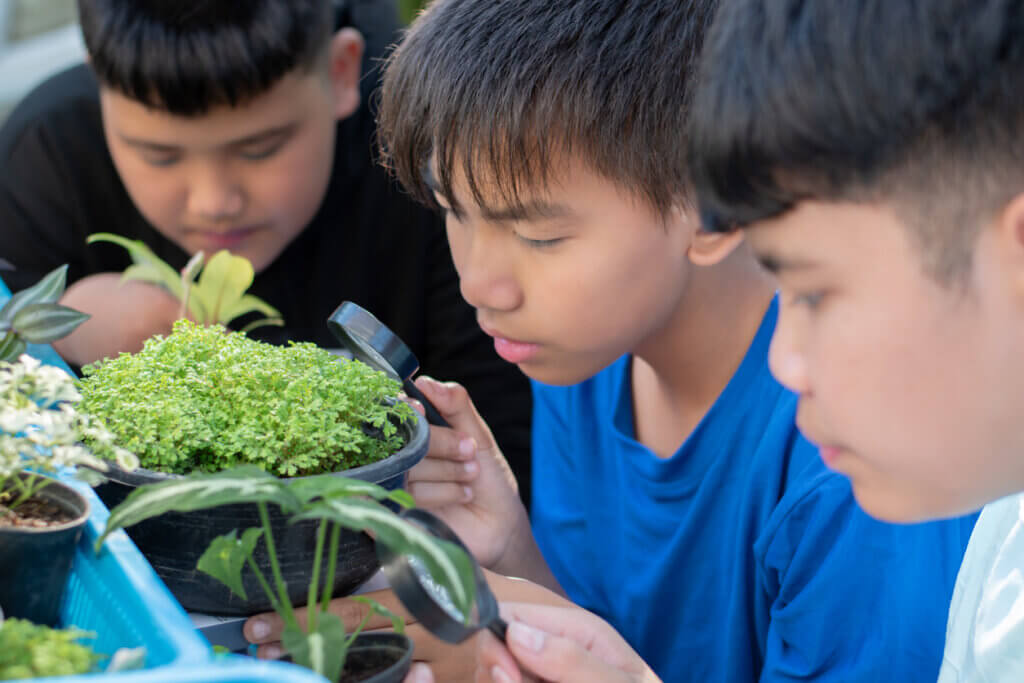Students are noticing extreme heat, flooding, wildfires, and other effects of climate change right in their communities. But our teachers do not have access to California-specific instructional materials on these topics. The good news: for the 2025–26 school year, that’s going to change.
Ten Strands and the San Mateo County Office of Education are developing free, supplemental instructional materials on climate change and environmental justice for grades K–12. All of this is in service of empowering students to be environmentally literate, engaged community members who are prepared to act for the well-being of their family, broader community, and environment. We’ve made exciting progress I’d like to share with you:
- A preview of the topics for each grade level
- An introduction to the new name of the instructional materials
- What teachers are saying so far
- How you can get involved

Preview of topics for each grade level
Climate change and environmental justice are big topics. Our goal was to start laying the foundation with one instructional unit per grade. Teachers told us, Don’t shy away from the tough topics—help us teach them because real life is what students want to learn about. We also heard the need to be age appropriate, solutions oriented, and trauma informed.
From the outset, we wanted to center the voices and experiences of those closest to the problem. We partnered with organizations serving communities most impacted by climate change and environmental injustice to help set the direction for each grade level. Then, we workshopped these ideas with teachers and other field experts.
The result is a set of interconnected topics that support state content standards and frameworks, aligned with students’ academic and social development:
| Grade | Topic | Unit Driving Question |
|---|---|---|
| K | Observing Our World | How can we understand the world around us? |
| 1 | Food Waste | How does the food we throw away impact our community and how can we throw away less food? |
| 2 | Open Space | How does open space help people, pollinators, plants, and animals? |
| 3 | Rising Temperatures | As California gets hotter, how do we keep our communities safe? |
| 4 | Electric Energy | What is the relationship between climate change and reliable, clean electricity, and how can our community become more energy resilient? |
| 5 | Fire and Forest Management | How can Californians use fire responsibly to care for our forests? |
| 6 | Food Systems | How does a changing climate impact our food and what can we do about it? |
| 7 | Land Subsidence and Groundwater | Why is the Central Valley sinking and what can we do about it? |
| 8 | Air Quality | What is causing unhealthy air quality in Riverside and San Bernardino counties, and what can be done about it? |
| 9-10: Life Science | Water Restrictions and Ecosystems | How can we manage water in California communities and ecosystems in a changing climate? |
| 9-10: Physical Science | Consumer Products and GHG Emissions | What impact do consumer products have on global greenhouse gas emissions? |
| 11-12: Intro to Environmental Justice | Environmental Justice | Why does environmental injustice persist, and what can we do about it? |
| 11-12: Environmental Justice Case Studies | Environmental Justice | How does bringing together many different types of evidence make an effective case for environmental justice? |
Some of these topics may be refined after this fall’s field test. Read on to learn how you can get involved.
Introducing: Seeds to Solutions™
Our North Star is to empower students and teachers especially because of the overwhelm of climate change and environmental injustice. Empowerment is woven into every thread of these instructional materials. Did you notice how many of the unit driving questions above ask, What can we do about it?
It was natural to have a name evoking that same spirit of empowerment. That’s why we’re excited to share the name of these free, open education resources: Seeds to Solutions.

The name Seeds to Solutions was surfaced through extensive input from students, educators, community organizations, and partners. This name reflects what we heard: the importance of being hopeful, forward looking, inclusive, active, and empowering.

Feedback from teachers in their own words
Since our last update on this project, Seeds to Solutions has been field tested by teachers in classrooms across the state. Teachers are reporting that students are very engaged in the material and that it’s easy to incorporate into their instruction. Here is some of what we’re hearing:
I can tell students were interested in the lessons because, even when working in groups to read passages, students who don’t usually talk in class discussions were actively participating in the discussions this time. —Elementary school teacher
My students have never thought about stuff like this before, and now they’re sharing it. One girl said this was the only class that she went home and talked to her parents about. —High school teacher
Our community is a combination of young people from both urban and rural agriculture backgrounds, so it was interesting hearing them share different perspectives on land and water use. Some of our kids started to become experts in the room that other students started going to for questions. —Middle school teacher
Students seemed determined that this would not be as big a problem in their area in the future because they were helping to inform people and take action. —Elementary school teacher
The engagement from students is very promising. Our biggest learning is that teachers wish there were more time to teach each unit, which is understandable. With limited instructional time, we’ve been working on ways to help teachers scale the lessons up or down. That way, teachers can lay a solid foundation, with the option to expand if possible.
We’ll be field testing Seeds to Solutions in more classrooms this fall so we can continue to refine the lessons based on teacher and student feedback. We still need more teachers to participate; please consider signing up. I’d like to recognize and give a thank you to teacher leaders in the following districts signed up to participate in this fall’s field test so far:

How you can stay involved
- Participate in fall field testing: We’re looking for K–8 teachers across California to field test one Seeds to Solutions instructional unit in their classroom. This is an opportunity to shape the lessons and earn a $750 stipend. Learn more about how to participate.
- Sign up to get updates: Seeds to Solutions is slated to be available for the 2025–26 school year. Be the first to learn when the materials are available by signing up for updates. We may also have opportunities for you to make your voice heard and for teachers to get professional learning.
Getting Seeds to Solutions into this home stretch has been a collaborative effort with community partners, our steering committee, curriculum-development and writing partners, funders, agency partners, staff, teachers, students, and environmental literacy champions. It is a reminder that everyone has a role to play in addressing climate change and environmental injustice.
I look forward to sharing future updates with you. And next year, we’ll plant the seeds together and see what grows.


2 Responses
Dear Dr. Jones:
I read today in the Los Angeles Times about LAUSD teachers working hard to provide climate change curriculum for their students. The programs you’re developing look great.
In the meantime, or as a supplement, I wanted to let you know of an existing grade 9-12 climate change curriculum program that’s available for free download through Western Washington University. WWU is part of the Washington State system that’s parallel to our CSU system here in California.
Big World, Small Planet, Module 4: Wants versus Needs: Pushing the Boundaries focuses primarily on climate change. It’s aligned with NGSS and other standards, contains both content and activities, and offers a student edition and a teacher edition for each module. It can be found at https://cedar.wwu.edu/ftf_allpublications/7/.
The entire four-module series is available for free. It covers sustainability concepts, systems thinking, nature connection, air quality, water, consumerism, and other issues. The series can be used together for a semester-long program or as stand-alone lessons or units.
I was the lead author of the series, working with WWU sustainability professor emeritus Victor Nolet, Ph.D. on the project.
If I can provide any additional information about the materials or ways to use them, I’d be happy to talk with you or other Ten Strands staff.
All the best to you,
Ann Hempelmann
Hi, Roni.
I work at SDSU Research Foundation across several programs focused on the environment and environmental justice.
While my current role does not involve K-12 students, I continue to remain connected to the youth climate/environment educator community.
One important K-12 climate education network is CLEAN (https://cleanet.org/index.html), where I don’t believe I’ve ever seen anything from Ten Strands posted. I would like to suggest that you check CLEAN out and consider posting announcements such as this one about Seeds to Solutions, any upcoming internship or employment opportunities, and otherwise learn and share experiences and reflections with the community.
And if you already know about CLEAN, then please disregard the above and keep doing great work!
Lisa